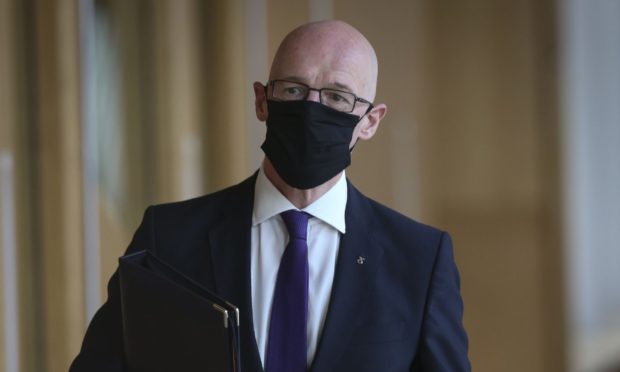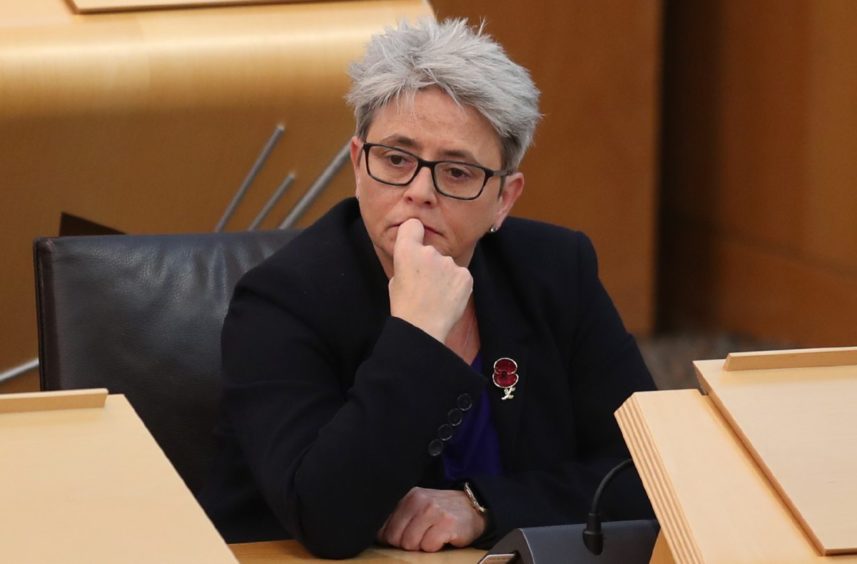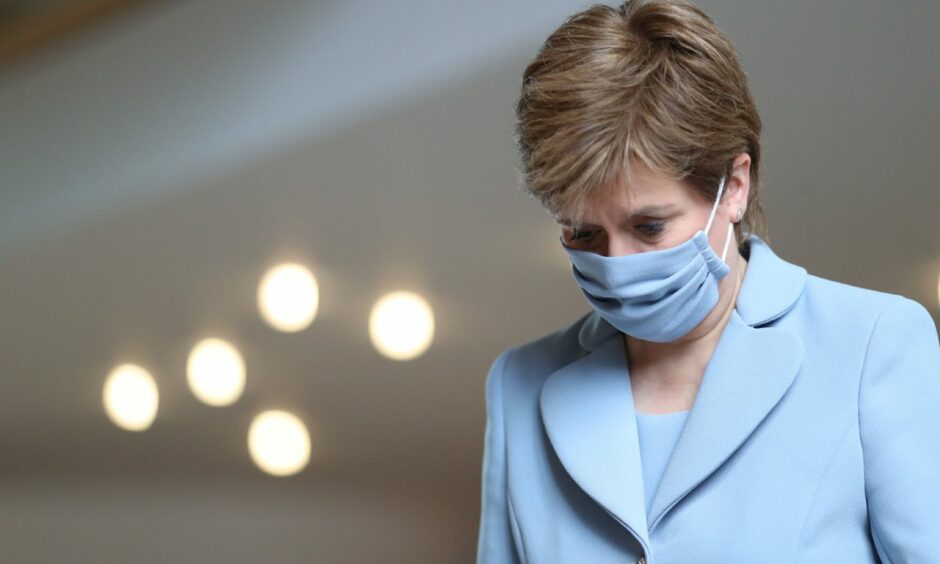Covid recovery secretary John Swinney has apologised after being reported to the UK Statistics Authority over his use of a “fake news” infographic.
Scottish Conservative health spokeswoman Annie Wells wrote to the UK’s National Statistician, Sir Ian Diamond, on Wednesday to highlight the use of an unverified graphic that made claims about the effectiveness of wearing a mask against Covid-19.
Mr Swinney tweeted a badly cropped image used in a well-known meme with claims about mask protection shortly before 10am on Monday morning. Its figures have been strongly disputed by international fact checking websites.
The graphic claims there is no risk of transmitting the deadly virus as long as you wear a mask and stand six feet apart. It also makes several other claims about the percentage risk from wearing or not wearing a face mask.
Mr Swinney tweeted the infographic with the caption: “As we move to Level 0 in Scotland – marking good progress on our careful process of relaxing restrictions – this is a helpful graphic showing why we must use face coverings and keep our distance.”
As we move to Level 0 in Scotland – marking good progress on our careful process of relaxing restrictions – this is a helpful graphic showing why we must use face coverings and keep our distance. #staysafe pic.twitter.com/AcyrEBmVgb
— John Swinney (@JohnSwinney) July 19, 2021
The same “fakes news” was also shared by former SNP government minister Roseanna Cunningham and the leader of Edinburgh Council, SNP councillor Adam McVey, all within around an hour of each other.
The claims shared in the image do not appear to be supported by evidence and the original source of the graphic is unclear. No Scottish Government official has yet provided a source for the claims.
Potentially dangerous
Ms Wells said: “More than 48 hours after journalists and the Scottish Conservatives raised concerns about this misleading graphic, no action has been taken.
“A message from the deputy first minister that is essentially fake news has been retweeted nearly 1,000 times and has likely reached an audience in the tens or possibly even hundreds of thousands.
“We have given the SNP every opportunity to admit their mistake and fix this. It has also been raised directly with the first minister and Scottish Government officials by the media.
“The continued use of an unverified graphic like this is potentially dangerous. It undermines the serious public health message that masks can limit the spread of the virus.
“It may even convince some people that there is zero risk from Covid in certain situations, which is not supported by science.
“The repeatedly poor judgement from the SNP Government on this issue is concerning. Fake news must be stamped out and we have reported this graphic to the UK Statistics Authority for their input, since SNP ministers will not act.”
Fake news
Mr Swinney finally removed the tweet on Wednesday evening and apologised after three days of ignoring calls for it to be pulled down.
He said: “I shared an image on Monday to illustrate that masks and distancing can help stop Covid transmission.
“I have now deleted the image as the figures in it were not verified. Sorry for that. But the message is unchanged: masks and distancing remain critical to beating this virus.”
The illustration used by Mr Swinney has been widely shared on social media with different figures and in multiple languages including Catalan, French, Burmese and Spanish, but has been debunked by fact checking services such as Reuters and the Danish website TjekDet.
The infographic has also been adopted as a popular meme with parody versions showing one of the figures in the final row stating an unpopular opinion and making the listener walk away, thus leading to “0% risk of transmission.”
A leading “false information” expert warned on Tuesday that even well-intended memes and infographics which turn out to be false can undermine public trust.
Speaking during a Covid briefing at Bute House, Nicola Sturgeon refused to say if she believes the image is misleading but said the “point” Mr Swinney was trying to put across on face coverings was “important”.
Despite criticism, the Scottish Covid secretary left the image on his personal twitter account and refused to acknowledge that the figures quoted were made up when he was approached by us for comment.
Last month, health secretary Humza Yousaf was rebuked by the UK Statistics Authority for “inaccurate” child Covid claims, after he was reported by the Scottish Conservatives.
Not worried
Asked whether she was worried about fake news memes and misinformation undermining the public health message, and whether it would arm bad state actors who use false information for disruption, Ms Sturgeon said she was not.
She added: “I do recognise the importance of people like me and the deputy first minister and ministers sharing verified information.
“The point we’re trying to illustrate is a really important one, it is the case face coverings protect us. I don’t think we should lose sight of that point.”
Ms Sturgeon continued: “The deputy first minister tweeted an image yesterday that was intended to illustrate what is absolutely the case – that wearing face masks protects people from transmission of the virus.
📺 Watch live: First Minister Nicola Sturgeon holds a press conference on #coronavirus (#COVIDー19).
Joining the First Minister today is Deputy Chief Medical Officer, Dr Nicola Steedman. https://t.co/UQdpA6pzzf
— Scottish Government (@scotgov) July 20, 2021
“What I will say in addition to that is that I think we recognise that in seeking to illustrate that, we should take care to use properly verified graphics and we’ll certainly take that on board in terms of how we tweet that information in future.
“But getting the general point across, he is absolutely right to seek to do, as I seek to do on a general, ongoing basis as well.”
IN FULL: Annie Wells’ full letter to the UK Statistics Authority
Dear Sir Ian,
Misleading statistics used by the Scottish Deputy First Minister and Cabinet Secretary for Covid Recovery.
I write to you regarding the above matter.
You may be aware of recent media reports concerning statistics that were used by the deputy first minister and cabinet secretary for Covid recovery, John Swinney MSP.
In a graphic posted online, Mr Swinney made various claims about the effectiveness of wearing masks to prevent Covid, most of which appear to be unfounded. International fact-checking websites have previously investigated some of the claims and found them to be at least partly false.
After reports emerged in the Scottish press, the deputy first minister, via a spokesperson, refused to provide a source for the information in the graphic. Neither was it deleted.
The first minister subsequently said she would “reflect” on the use of the graphic but 24 hours later, it still had not been deleted, nor have the Scottish Government provided a source for the information.
At the time of this statement, these statistics were not available in the public domain. They appear to be unverified and misleading, at best. The Scottish Government have been asked to release the statistics repeatedly and refused to do so. Neither have they formally corrected the information and deleted the erroneous statistics.
The correct use of statistics is vital, particularly when issuing public health guidance during a pandemic. As such, I would be grateful if you could investigate this matter and take appropriate action as you see fit.
Yours sincerely,
Annie Wells MSP


